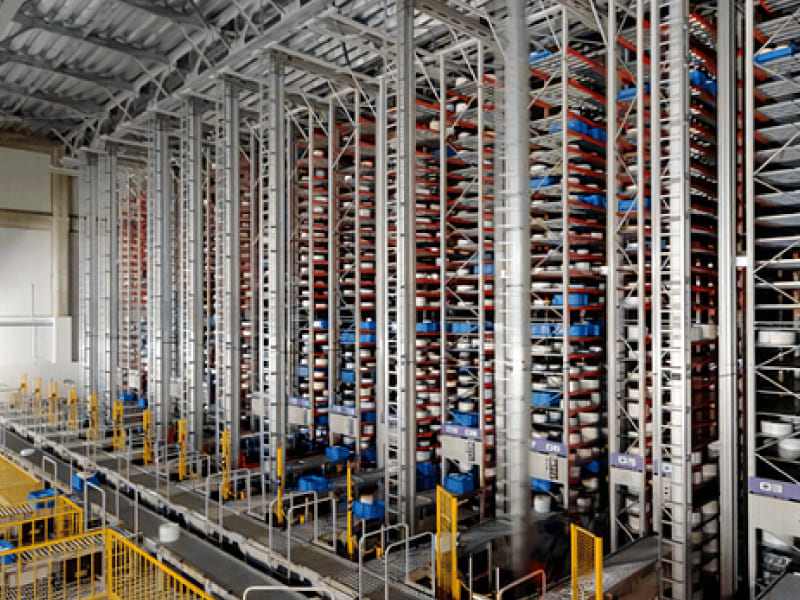Call Us :8615298359310
Call Us :8615298359310
With regarding to the upcoming increasing floor space cost, space utilization has been prioritized as the main concern for many shareholders in intralogistics and warehousing.
For its vertical space utilization, one solution has gained significant traction is the high bay warehouse. This article delves into the intricacies of high bay warehouses, exploring their definitions, advantages, and best practices.
What is a High Bay Warehouse?
A high bay warehouse is characterized by its towering storage systems, typically reaching heights of 40 feet (12 meters) or more. These facilities leverage vertical space to maximize storage capacity, often extending upwards of 100 feet (30 meters) or even higher in some cases. The defining feature of a high bay warehouse is its ability to utilize the full height of the building for storage purposes, notably increasing the cubic storage volume compared to traditional warehouses.
High bay warehouses are distinguished by their:
These elements combine to create a storage environment that efficiently utilizes vertical space while maintaining accessibility and operational efficiency.

The Evolution of High Bay Warehousing
The concept of high bay warehousing emerged in the 1960s as a response to the growing need for increased storage capacity in urban areas where land was becoming scarce and expensive. Initially, these warehouses relied on manual operations and basic lifting equipment. However, as technology advanced, so did the capabilities of high bay warehouses.
The integration of automation and computerized inventory management systems in the 1980s and 1990s revolutionized high bay warehousing. This technological leap enabled more efficient use of vertical space and improved inventory control, setting the stage for the sophisticated high bay warehouses we see today.
Advantages of High Bay Warehouse Systems
High bay warehouses offer numerous benefits that make them an attractive option for businesses with substantial storage needs:
1. Maximized storage density: By utilizing vertical space, high bay warehouses can store significantly more inventory per square foot of floor space.
2. Reduced land requirements: The vertical configuration allows businesses to expand storage capacity without acquiring additional land.
3. Improved inventory management: Advanced systems in high bay warehouses enable precise tracking and rapid retrieval of stored items.
4. Enhanced operational efficiency: Automated systems can operate 24/7, increasing throughput and reducing labor costs.
5. Heightened security: Limited access points and automated handling reduce the risk of theft and damage to inventory.
Challenges and Considerations
While high-bay warehouses offer substantial benefits, challenges are also inevitable:
Optimal Storage Solutions for High Bay Warehouses
Several storage solutions are particularly well-suited for high bay warehouses:
1. Pallet racking systems: These versatile systems can be configured to reach great heights and accommodate various load sizes.
2. Narrow Asie Racking: This configuration maximizes storage density by reducing aisle width, requiring specialized handling equipment.
3. Drive-in and drive-through racking: Ideal for high-density storage of homogeneous products, these systems allow forklifts to enter the racking structure.
4. Automated storage and retrieval systems (AS/RS): These computer-controlled systems use automated cranes to store and retrieve pallets or totes, maximizing efficiency in high bay environments.
5. Shuttle systems: Automated carts or shuttles move along racking levels to store and retrieve goods, offering high-density storage with rapid access.
Automation and Technology in High Bay Facilities
Automation plays a crucial role in the efficiency of high bay warehouses. Key technologies include:

Best Practices for Implementing High Bay Warehousing
To maximize the benefits of high bay warehousing, consider the following best practices:
1. Conduct a thorough needs assessment to determine if a high bay solution is appropriate for your business.
2. Invest in a robust warehouse management system to coordinate operations effectively.
3. Implement rigorous safety protocols to address the unique challenges of working at height.
4. Provide comprehensive training for staff on the use of specialized equipment and systems.
5. Regularly maintain and update automation systems to ensure optimal performance.
Industry Applications
High bay warehouses are widely applied across multiple industries:
It’s promising to gain a 30%~50% increase in storage capacity and a 20~30% reduction in order fulfillment time.
Future Trends in High Bay Warehousing
The future of high bay warehousing is closely tied to technological advancements:
Final Thoughts
For businesses dealing with large inventories (even high categories, low SKUs), just-in-time fulfillment, or facing space constraints, a high bay warehouse featuring increased storage density, and enhanced operational efficiency has emerged as an attractive option.
If you want to know what kind of storage solution fits best your specific needs, don’t hesitate to contact us, our team of experts will advise you on the best solution.
Copyright © 2024 Jiangsu VISON Logistics Technology Co., Ltd. All Rights Reserved.  Network Supported
Network Supported
Sitemap | Blog | Xml | Privacy Policy